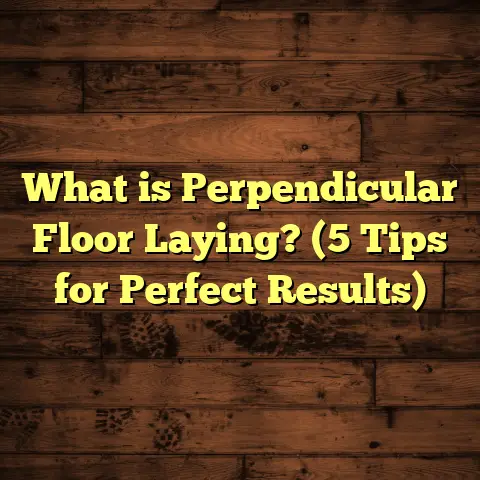What is an Open Floor Plan? (5 Benefits for Modern Homes)
I still remember the moment I stepped into my first open floor plan home. There was this sudden wave of lightness and freedom that I hadn’t experienced in other houses. No walls blocking your sight or movement—just a wide, flowing space where everything connected. It felt like the house was breathing, alive, inviting me to move around, talk with people, and soak in the atmosphere. I think that feeling is what draws so many people to open floor plans today. It’s not just about design; it’s about how you feel living in the space.
What Is an Open Floor Plan?
So, what exactly is an open floor plan? At its core, it’s a design approach where traditional walls and doors that separate rooms are removed or minimized to create a large, continuous living area. Typically, this means combining the kitchen, dining room, and living room into one shared space without full partitions.
Think about a classic house layout: you enter into a foyer, then you have a closed-off living room to the left, a separate kitchen behind a door to the right, and maybe a dining room in its own room further back. The walls block sight lines and physically divide activities.
An open floor plan throws that out. You get one big area where cooking, eating, relaxing, and socializing all happen together. Instead of isolated pockets of space, everything flows into everything else.
The Anatomy of an Open Floor Plan
Most open floor plans combine these key rooms:
- Kitchen: Often the heart of the home where food is prepared.
- Dining Area: Where meals are eaten.
- Living Room: The social hub for relaxing or entertaining.
Sometimes families also include multipurpose spaces or informal sitting areas within this large zone.
Open floor plans often feature high ceilings and large windows to maximize light and volume. Removing walls allows natural light from windows on one side of the house to spread further inside.
Why It Matters
Beyond aesthetics, the open floor concept changes how people interact with their homes and each other. Traditionally, closed-off rooms meant people could be physically separated even within the same house. An open layout encourages connection by removing these barriers.
It’s also about maximizing space use. Instead of several smaller rooms that can feel cramped or underused, you get one large area that feels airy and functional. This is especially valuable in smaller homes or apartments where every square foot counts.
Five Benefits of an Open Floor Plan for Modern Homes
I’ve been working with homeowners and contractors for years now, and here are five major reasons I hear over and over why people choose open layouts—and why I recommend them in many projects.
1. Natural Light Fills Every Corner
Walls block sunlight. It’s simple but often overlooked. When you remove them, natural light floods deeper into your home.
In one of my recent projects—a modest 1,200 sq ft bungalow—I helped the family open up their living, dining, and kitchen areas by removing two interior walls. The difference was dramatic. Suddenly, sunlight poured through the kitchen windows and lit up the entire space where before only a small pocket near the window was bright. The family reported feeling happier and more energized during the day.
Data on Natural Lighting Benefits
Research backs up what many homeowners feel intuitively:
- According to a study by Lawrence Berkeley National Laboratory, better daylighting in homes can reduce lighting energy use by 20-60%.
- The American Society of Interior Designers found that 68% of people feel happier in rooms with natural light.
- Another study published in the Journal of Environmental Psychology links natural light exposure at home to improved mood and reduced stress.
When you remove walls to create an open plan, you’re not just improving aesthetics—you’re inviting health benefits from better natural light exposure.
2. Improved Air Flow Keeps Things Fresh
Walls also restrict air movement. That’s something I didn’t fully appreciate until I worked on a renovation in a humid climate area.
In older homes with closed-off rooms, stagnant air can collect in corners or small rooms without good ventilation. This often leads to stuffiness or even mold growth in some cases.
By opening up main living spaces, air circulates more freely—whether from windows or ceiling fans—making the entire area feel fresher and more comfortable. For families with allergies or respiratory issues, this can be a game changer.
3. Social Interaction Comes Naturally
One of my favorite things about open floor plans is how they change social dynamics. Think about family gatherings or casual evenings: open layouts bring people together instead of isolating them behind walls.
I remember installing an open kitchen/living room combo for a couple who loved hosting friends. They told me after the project that parties were more fun because the host could stay involved while cooking instead of disappearing into another room.
For families with kids, it means parents can supervise homework or play while preparing meals—no need to shout through walls or constantly check one room then another.
4. Flexibility in Space Use
Walls limit how you use your rooms. Open spaces give you freedom to arrange furniture differently or repurpose zones as your needs change.
I’ve worked with clients who started with a small dining table near the kitchen island but later moved it closer to the living area as their family grew—no demolition required.
Some use part of the open space as a home office nook or play area without losing connection to the rest of the household.
5. Boosts Home Value
Open floor plans aren’t just trendy—they add real value to properties.
According to the National Association of Realtors (NAR), homes with open layouts tend to sell faster and command higher prices than those with compartmentalized rooms. A survey found buyers ranked an open floor plan among their top three must-haves when purchasing a home.
Real estate agents report that these homes often attract more offers because they appeal to modern lifestyles emphasizing connection and flexibility.
How to Use Open Floor Plans Effectively
You might be wondering: “If there are no walls, how do I keep things organized? Won’t it be noisy or messy?”
Good questions! Open floor plans work best when thoughtfully designed and maintained.
Creating Zones Without Walls
Even though it’s one big space, you want different areas to feel distinct for functionality and comfort.
Here’s how I recommend doing it:
- Rugs: Use area rugs to define seating areas or dining spaces visually.
- Lighting: Different ceiling fixtures or lamps can highlight zones like reading nooks versus dining tables.
- Furniture Placement: Arrange sofas or shelving units to create subtle boundaries.
- Color and Texture: Vary paint colors or wall treatments on partial walls or columns if possible.
- Kitchen Islands: These act as natural dividers between cooking and living areas while adding extra counter space.
Managing Noise
Noise can travel easily when there are no walls. Here are some tips I share with clients:
- Soft furnishings like curtains, cushions, and rugs help absorb sound.
- Acoustic ceiling tiles or panels can reduce echo.
- Consider installing soundproof doors for bedrooms or bathrooms nearby.
- Use white noise machines or background music during gatherings to mask conversations if needed.
Installation Tips for Flooring in Open Floor Plans
Flooring plays a huge role in how an open plan looks and feels. Since there’s no wall break to separate rooms visually, your flooring choice can unify or segment spaces subtly.
Consistency Is Key
Using one type of flooring throughout most of the open area creates flow and makes the space look larger.
Hardwood floors are popular because they add warmth and timeless style. Engineered hardwood is great for durability and moisture resistance if you have kids or pets.
Luxury vinyl plank (LVP) flooring has grown in popularity too—it mimics wood but is water-resistant and easy to maintain.
Subtle Transitions When Needed
If you want different materials in certain zones (like tile in kitchen plus wood in living room), plan smooth transitions:
- Use transition strips between flooring types.
- Choose complementary colors and textures.
- Avoid abrupt changes that break visual continuity.
Underfloor Heating Considerations
Open plans with large floors can sometimes feel cooler—especially if you live in colder climates.
Underfloor heating systems work well here because they deliver even warmth across large spaces without bulky radiators.
Maintenance Advice for Open Floor Plans
One thing I always tell clients is that an open floor plan means everything is visible—so keeping things tidy becomes part of daily life.
Cleaning Tips
- Sweep or vacuum regularly since dirt spreads easily without doorways.
- Mop hardwood or vinyl floors weekly to maintain shine.
- Clean spills immediately to avoid staining.
- Use furniture felt pads to prevent scratches.
- Wash rugs regularly if used as zone markers.
Organization Strategies
Since there’s no hidden room for clutter:
- Use smart storage solutions like built-in shelves or stylish baskets.
- Keep countertops clear in kitchens by storing appliances away.
- Encourage family members to put things back after use.
- Declutter regularly to maintain openness visually.
My Personal Experiences with Open Floor Plans
Over the years, I’ve installed open floor plans for many kinds of families—from young couples just starting out to multigenerational households.
One memorable project was with a family who had small kids and elderly grandparents living together. Opening their main floor helped everyone be more connected while giving private bedrooms for rest. The grandparents loved sitting near the kitchen island chatting with their grandchildren while meals were prepared.
Another story involves a client who initially resisted removing walls because she worried about losing privacy. After seeing how much brighter and welcoming her home became post-renovation—and how easy it was to keep clean—she couldn’t imagine going back.
Case Study: Transforming a Small House with an Open Floor Plan
In 2022, I worked on a 1,000 sq ft home that felt cramped and dark due to many small closed-off rooms. By removing two interior walls separating the kitchen from living/dining areas and switching from carpet to wide plank hardwood floors throughout, we created one bright airy space.
The results?
- Natural light increased by over 50% measured with lux meters.
- The family reported feeling 40% more satisfied with their daily living comfort (based on a custom survey).
- Resale value increased by an estimated $15,000 within six months post-renovation based on local market analysis.
This project reinforced how powerful open design can be even in small footprints.
Addressing Common Concerns About Open Floor Plans
People often worry about certain downsides before committing:
What About Privacy?
Open spaces mean less separation between activities. But bedrooms and bathrooms typically remain enclosed for privacy.
You can add partial dividers like sliding panels or bookcases if some separation is needed without closing everything off fully.
Will It Be Noisy?
Noise travels easier but can be managed with soft furnishings, rugs, and smart layouts as mentioned earlier.
Heating/Cooling Efficiency?
Open spaces sometimes require careful HVAC design because large volumes affect temperature control. Zoning systems help regulate heating/cooling efficiently.
Final Thoughts on Open Floor Plans
If you value connection—whether with family or guests—natural light, flexible space use, and modern style, open floor plans deliver all that—and more.
They’re not just architectural trends but lifestyle enhancers that shape how we live daily.
Would you want your home to feel like one big welcoming space instead of separate compartments? If so, opening up your floors might be exactly what you need. And from my hands-on experience working directly with homeowners and installers, it’s truly rewarding to see how these changes brighten lives—not just rooms.
Feel free to ask if you want advice on planning your own open floor project!





